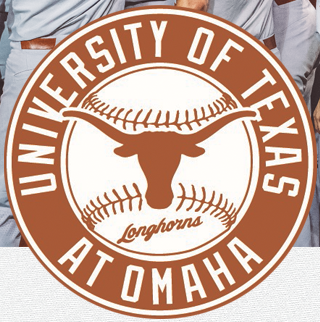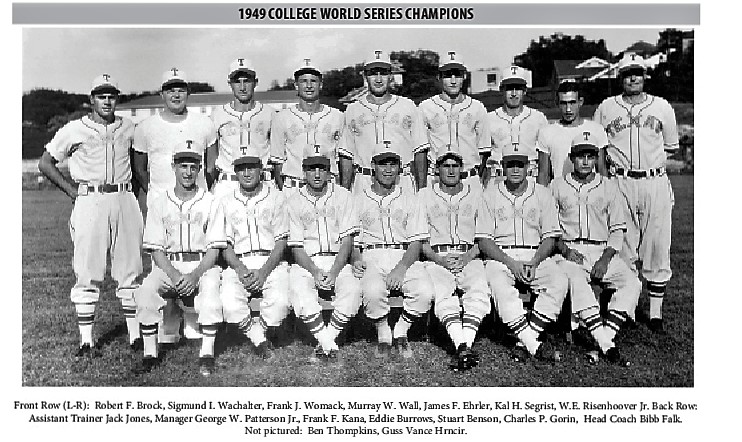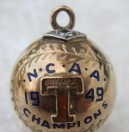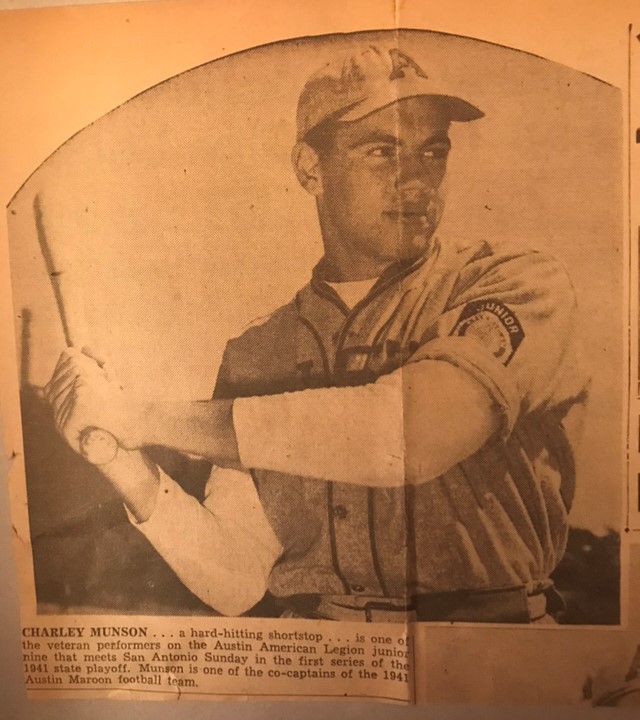’49 Longhorns: Unlikely champs almost didn’t get their chance
By Gaylon Krizak
Ten games into the 1949 baseball season, it was clear to at least one observer that Bibb Falk’s latest edition of the Texas Longhorns just didn’t measure up to its predecessors.
Granted, the bar the ’49 Longhorns faced was as high as the fence that sat atop the limestone hill that stretched across the outfield at Clark Field, Texas’ baseball home since 1928. The Steers, as the Longhorns frequently were referred to in print in those days, were going for their sixth consecutive Southwest Conference championship and their 28th in the 35-year history of the SWC.
This also was the third year of the NCAA baseball tournament, and the Texas team of 1949 appeared to have some unfinished business to attend to. With two-sport superstar Bobby Layne leading the way on the mound as a junior, the 1947 Longhorns had reached the Western Division final in Denver before losing, in what then was a single-elimination format, an 8-7 decision to eventual national champion California.
The following year, chiefly citing summer job commitments and the monthlong delay between the end of the regular season and the start of the NCAA tourney, Texas coach Bibb Falk opted to skip the tournament.
To get their own chance, the 1949 Longhorns first would have to win the SWC, since no more than one team from each conference qualified for the eight-team field (plus any teams in district playoffs needed to determine some of the participants in the tournament). And 10 games into the season, with conference play set to begin, Texas was not performing up to Texas’ standards.
As a team, the Longhorns were batting .228, including an anemic .181 against left-handers, with a staff ERA of 3.87. In the three previous years immediately following World War II, Texas had not lost more than four games in a season and had dropped just two in the entire 1948 campaign. Through 10 games, the ’49 Longhorns were 6-4, including three losses in four tries against minor-league professional teams.
The low point, arguably, came March 23 as Texas was going for a three-game sweep of Ohio State. Instead, Buckeyes lefty Dick Hess limited the Longhorns to two singles in nine innings, giving Ohio State a 5-1 victory that ended Texas’ 36-game winning streak at Clark Field against collegiate competition that dated back to 1946.
So – fittingly, perhaps – in the April Fools’ Day edition of the Austin American, staff writer Seale Doss offered this blunt assessment of the team:
“Shy at the plate, this ’49 club had been laughed off as Bibb Falk’s poorest team in years …”
Ironically, the past tense proved more prophetic than the dire pronouncement that contained it.
In hindsight, the first of the University of Texas’ 54 NCAA team championships, six of which have come in baseball, was accomplished by a team most like two that followed in its wake: the 1969 football and 1983 baseball squads. All three were great teams in their own right, but all three to this day still get unfavorably compared to their immediate, non-champion predecessors.
The ’69 football team was 11-0 and beat Arkansas and Notre Dame in two of the most memorable games in UT history. Yet many – including some players who were on both teams – claim that, by the end of the season, the 9-1-1 team in 1968 was better, its loss and tie coming in the first two games of the season while the newly created Wishbone offense was still having its kinks worked out on the fly.
The ’83 baseball team, meanwhile, won a school-record 66 games and featured a pitching staff that may have been the best in NCAA history; led by Roger Clemens, Calvin Schiraldi, Mike Capel and Kirk Killingsworth, Texas led the nation with a 2.72 ERA. All four were on the ’82 staff as well, with only Schiraldi having a markedly better season in ’83, and they led the Longhorns to (and this is no typo) a 57-4 record going into the College World Series. The Longhorns then won their first two CWS games before falling to eventual champ Miami and runner-up Wichita State.
As mentioned earlier, Falk chose not to enter the 1948 Longhorns in the tournament at all. As Weldon Hart of the Austin Statesman explained just after the ’48 season ended, there were “too many factors competing against the Longhorns.”
“The playoffs come along a month after the Southwest Conference season was over. Meanwhile the Texas team would have been disbanded for final examinations and a visit home, reassembled for only a few days of practice at best – and without several of their best players.
“Shortstop Chick Zomlefer probably will have signed a professional contract … and Pitcher Bobby Layne will be attending summer school at Texas Tech. Several players plan to go to summer school here. Others will want to report to summer jobs.
“As Coach Falk noted, it would not be possible for Texas to field the same team that won the conference championship. To do any less, he feels, would not reflect deserved credit on the University and the conference.”
A shame, since the 1948 team may well have been the best of the 25 he coached at Texas. Zomlefer, a three-time All-SWC shortstop, signed with the Baltimore Orioles – then the main farm club for the Cleveland Indians – nine days after the season ended. Layne, better known as a Hall of Fame quarterback, finished his career unbeaten in SWC games; like Zomlefer, he was a unanimous all-conference pick. The Longhorns went 18-1 against collegiate competition, losing 8-7 midseason at Baylor, and 20-2 overall.
As the 1949 Longhorns began to hit their stride, winning their first seven conference games as part of an overall 10-game streak, Falk again was forced to confront the possibility of a decision on the NCAA tournament. And, once again, as he spelled out in an April 19 piece by Austin American sports editor Jack Gallagher, Falk leaned hard toward sitting it out:
“Every year around this time I hear talk of the NCAA baseball tourney. But I don’t want any part of it.
“Look at it this way: It means a layover of over five weeks for us. It means additional expense and practically no return. It means delaying the start of professional careers for many players on the club. …
“We tried using a patched-up team at Denver two years ago and it was no go. We were out of shape; hadn’t played together in over a month.
“Bobby Layne had not pitched a ball for 30 days. He wasn’t in any kind of shape to pitch in the intercollegiate championships.
“This NCAA baseball championship is a fine thing for the Eastern and Western schools. They finish their school year about a month after us, and can move into the playoffs without sitting around for five weeks like we have to do. It’s a good thing for them, this tournament, but I wish they would keep it to themselves instead of trying to put pressure on me to get my team into it every year.”
A 10-4 rout of Baylor seemed to awaken the slumbering Texas bats. Including that 12-hit outburst, the Longhorns batted at a .318 clip and averaged 8.6 runs per game – and also won three consecutive shutouts – in their 7-0 run to open SWC play. A 14-4 pounding of Texas A&M delayed a day by rain gave Texas a three-game lead over A&M and SMU … but also, because of weather issues as well as a two-game series with Valparaiso that was on the UT schedule but not Valpo’s, turned out to be the Longhorns’ only game in a 15-day stretch.
Apparently rusty after the long layoff and playing an inspired Baylor team still hanging on in the conference race, Texas traveled to Waco and suffered 11-5 and 3-2 defeats that cut the Longhorns’ league lead to 1½ games over the Bears and Aggies with six left to play. Wins in their next four games sent Texas to College Station needing one victory in the two-game series to wrap up the SWC title; two A&M wins plus two more over last-place Rice the following week would send the trophy to Aggieland.
The Aggies kept things interesting in the opener when ace Bobby Fretz limited the Longhorns to a single run on five hits and, for good measure, hit a three-run homer in A&M’s 6-1 victory. But Texas still had its ace to play, and Murray Wall came through. He tossed a two-hitter for his eighth win in SWC play – and his third of the week – complimented by Frank Kana’s home run in a four-run seventh inning as the Steers turned the tables and wrapped up the title with a 6-1 victory of their own.
Which, had Falk had his way, would have been the end of the 1949 story. But the NCAA alleviated at least one of his postseason concerns when the District 6 committee extended its tournament invitation and told the Longhorns that they would not have to play a qualifying district playoff; instead, Texas would host one of four best-of-3 regional series for the right to take part in the third College World Series, to be held for the first (and as it turned out, last) time in Wichita. Falk put the invitation to a team vote and reluctantly accepted their decision to participate.
(As Paul Tracy of the Statesman pointed out, there may have been another reason for Falk’s curmudgeonly stance: “Another minor consideration is the fact that the Texas coach does not draw a salary after May 31. His services in postseason playoffs are definitely beyond the call of duty.”)
In any event, the Longhorns hosted Oklahoma A&M (now State), which eliminated Kansas in a three-game District 5 playoff, in the Region C series 35 days after beating Texas A&M. The Cowboys made the Longhorns work to win the opener, but Texas scored the winning run in the bottom of the ninth on a sacrifice fly by Al Joe Hunt in a 3-2 victory. The Longhorns then breezed to a 7-3 win the following afternoon and, as Wall proclaimed in the dressing room afterward, “Wichita, here we come!”
Five days later, Texas took the field against St. John’s in the opening game of a newly instituted four-team double-elimination tournament and rolled 7-1. Wall tossed an eight-hitter, and star first baseman Tom Hamilton belted two home runs for the Longhorns. The train kept rolling the next night as Texas crushed Wake Forest 8-1 behind left-hander Charley Gorin’s complete game on the mound and an offense that churned out 15 hits, including Ed Kneuper’s homer.
The Longhorns were off Friday as Wake Forest eliminated defending champ Southern California in 12 innings, setting up, if necessary, a doubleheader Saturday for the NCAA title. Texas made the twinbill completely unnecessary, overpowering three Demon Deacons pitchers for 18 hits in a 10-3 victory. Second baseman Jim Shamblin totaled five hits (including a double and a triple) for a championship-game record that twice has been equaled but remains unsurpassed. After Wake Forest tied the score at 2-2 in the home half of the fourth, Texas broke the game open with two runs in the fifth, two more in the seventh, and four in the eighth, the big blow being a three-run homer by Hamilton that wrapped up the game for Texas and the tournament’s first-ever Most Outstanding Player award for him.
Hamilton’s homer capped one of the best seasons any Longhorn has enjoyed. He batted .417 and slugged .878 – including averages of .479 and .966 in SWC play – in 1949 and finished his three-year baseball career at .347/.653. He was the All-SWC first baseman in 1948 and ’49, and joined Wall on the 1949 American Baseball Coaches Association All-America first team.
He also compiled one of the best multisport careers in University history. As a freshman, he helped lead the UT basketball team to its first Final Four; three seasons later, as a senior, Hamilton was named to the 1949-50 All-SWC first team after completing his career as the school’s first 1,000-point scorer.
Wall, meanwhile, was the Longhorns’ stopper throughout the season. He was credited with eight of Texas’ 12 SWC wins and went 11-2 overall.
Hamilton and Wall led a solid UT contingent on the All-SWC baseball team that also included Kneuper (who also was on the All-America second team), Shamblin, and catcher Dan Watson. None except Wall returned for the sequel in 1950, which is another story (but a good one; promise) for another time.
So what changed this from a 6-4 team being “laughed off as Bibb Falk’s poorest team in years” to a 23-7 squad that hoisted the program’s first national championship trophy?
Start with pitching. Wall, as noted, was amazing, but far from alone. Gorin (hampered by a sore arm most of the season), Jim Ehrler, and Frank Womack also contributed in key spots and joined Wall to form one of the nation’s strongest staffs in 1950 as well.
Add a touch of Falk. Injuries – particularly a fractured left thumb suffered by Watson that kept him out of most of the pre-conference schedule – among other things kept the wily veteran coach from really settling on a lineup, but his hunches generally paid off. Specifically, Falk installed Womack, almost exclusively a relief pitcher most of the season, in the leadoff spot as an outfielder starting with the regional playoff opener with Oklahoma A&M; Womack responded by batting .458 in the postseason and .563 in the CWS, earning him a spot – along with Hamilton, Kneuper, Wall, Gorin and Watson – on the unofficial all-tournament team.
Mostly, though, it was the rugged non-conference schedule that helped forge the progressively sharp batting eyes of the Texas players. The Longhorns hit .303 in SWC games, .322 in the postseason, and .351 in Wichita.
Shy at the plate no longer, the 1949 Texas Longhorns bludgeoned their way into the winner’s circle, establishing a name for themselves in a program already loaded with tradition and setting a new standard that only five subsequent teams have matched.
Gaylon Krizak









